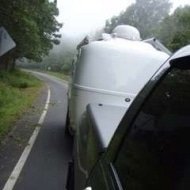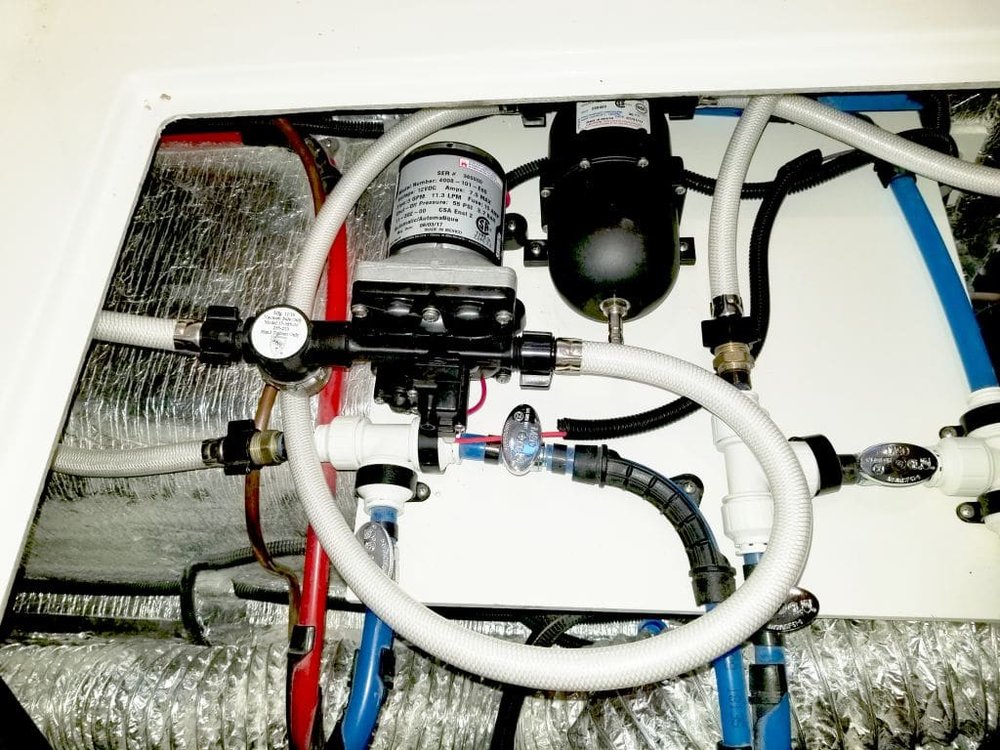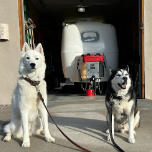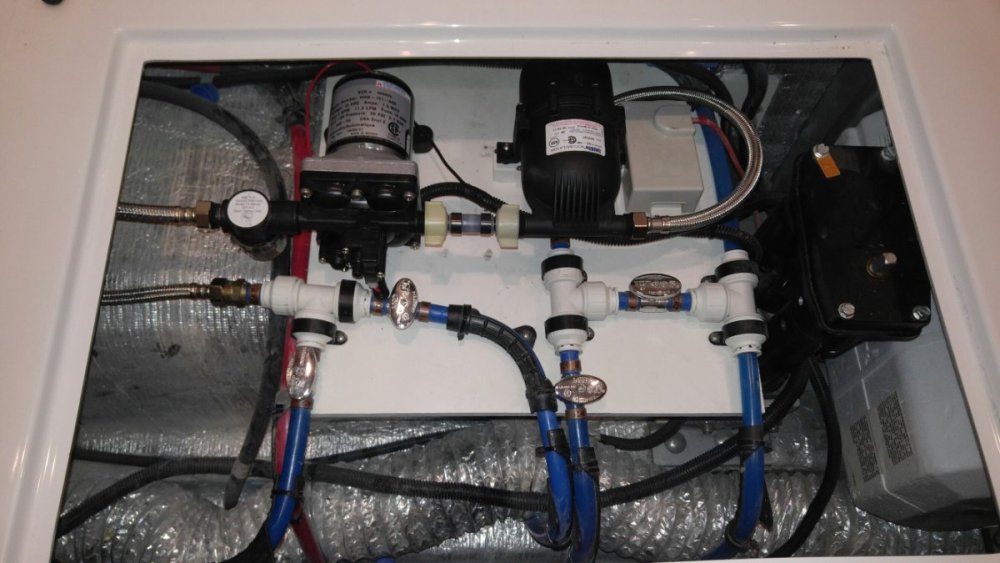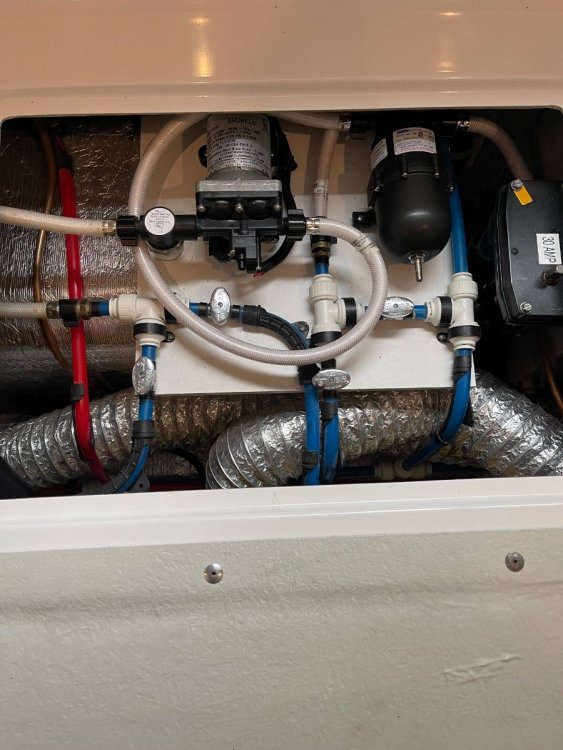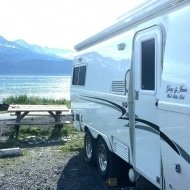Leaderboard
Popular Content
Showing content with the highest reputation on 07/02/2023 in all areas
-
As noted earlier, I had already set my inverter to 15A service. I did this in March, just after taking delivery, since I don’t have 30A at home. Today we tried running the Truma air conditioner on my brother’s outdoor 20A outlet. Surprisingly, it worked just fine! The ambient temperature was 75 degrees, and the thermostat was set at 66 degrees. The air conditioner was set on low mode. I didn’t try it on medium or high. Thanks for the input!4 points
-
Hopefully my recent experience will not happen to anyone else - but, if you ever have to re-pair your Voyager system for whatever reason here is how you do it. Over the winter I got in contact with the folks at ASA Electronics - the makers of the Voyager camera system that most of us have on our Ollies. The camera I had developed a weak and got moisture inside the lens. Almost immediately they sent me a replacement (free) but it wasn't until today that I got around to installing it. What I thought would be a fairly simple swap turned out to be a 3/4 or a day job! The old camera had already been removed because I had to send it in for ASA to confirm that it had a "seal" malfunction. So, I thought that all I would have to do is take the electricians tape that was used as a temporary covering the hole in the hull, feed the camera wire through the hull, plug it in and then reseal everything back up. Anyone that has actually taken a look at the "instruction" that comes with these cameras might remember that there are nothing but a few pictures (i.e. nothing is mentioned about re-pairing the camera and monitor). Well, once I plugged the new camera in and powered it up, the monitor would NOT automatically "pair" with it. Over the next two hours I tried everything that I could think of to get it to "pair" to no avail. Of course this meant that I traced all electrical connection to make sure power was getting to the camera which involved starting at the switch by the door, and undoing my nicely bundled wiring all the way back to the camera. Countless times I turned the camera off turned the monitor off - all for no change in the situation. Until I took a 15 minute break for lunch! It just so happened that after the lunch break I turned on the monitor first without powering on the camera. I noted that the screen on the monitor looked different than it had earlier and instructed me to hold down the first two buttons at the top of the monitor for 5 seconds. After doing this another screen popped up that instructed me to power on the camera. Within 10 seconds a picture appeared on the monitor and the "problem" was solved. Of course I then had to replace my nice wiring bundles, re-caulk the hole through the hull and put the "attic" back in order. But at least now I have a new camera that works. As an added bonus, I played around with the setting (access via the "menu" button) and improved the color and crispness of the monitor well beyond what I had with the first camera. Happy camper!😊 Bill3 points
-
Two possibilities for this one - 1 - take it apart and check the rubber washer. 2 - use a rubber mat - jar opener - to get a grip on it. Good luck! Bill3 points
-
"That guy" is who none of us want to be. Years ago, at Gooseberry falls cg in Minnesota, I thought we were having an earthquake, or an air attack. A guy near us got up (before quiet hours ended), fired up his extremely loud genset, and probably just made coffee. Lasted 15 minutes. But, of course, I couldn't go back to sleep. Good on Truma to take care of you, and your neighbors.3 points
-
Agree, and we still love "old school" butyl." Boat and trailer, wherever it makes sense.2 points
-
When I plugged my camper into a 20 amp breaker right after coming home with the camper, it tripped the breaker immediately (installed a 30amp shortly after that). I had not changed the settings on the Xantrex system yet. I believe it is drawing too much power for charging the lithium batteries, even with everything in the camper shut off. If you set it up right, it will charge at a lower rate and not trip the breaker. The inverter will select shore power whenever it's plugged in. I just unplug the shore power when I want to run the AC on inverter in this scenario, and when finished I plug the shore power in to top off the batteries. Others have covered the process for setting up the inverter for 15/20 amp service.2 points
-
Steve, back in April we camped in our son's driveway. It was cool and we didn't need AC. However, When I plugged into his outside outlet, I was tripping his breaker. I called Oliver and they had me lower a setting on the inverter. We weren't really using anything, but still had to adjust the inverter. Re-set it when we got ready to leave.2 points
-
FWIW, I run Dometic AC on 20amp circuit at home without any apparent issues.2 points
-
This week I added the much needed (by me) water accumulator tank to the outlet of of the water pump. The following may be helpful to you if you want to add to your trailer. FYI, the factory has added this to all the 2018 trailers as I understand. I decided to not only add the accumulator tank, but also utilize the silence kit which adds 2 ea. 30" hoses. The reason was to make the mounting more flexible. With the hoses, I would not be limited where I mounted the tank. (You may be able to find suitable hoses locally, but having everything arrive at my doorstep has it's benefits.) Parts I used: 1. ea SHURflo 182-200 Accumulator tank. $42.11 on Amazon today 1. ea SHURflo 94-591-01 Silencing kit. $25.94 on Amazon 1. Remove the 4 mounting screws in the pump base. 2. Turn off water pump, open the sink valve to relieve the water pressure, and remove the short white hose between the output port of the pump and the valves to the right of the pump. Have towels available because the faucet is higher than the pump so some water will drain out when you break the connections. 3. Before I remounted the pump, I tested several locations for the tank. I chose to move the pump as far to the left, allowing the tank to be mounted to the right. I dressed the hoses around trying to minimize any sharp turns and minimize the hoses hitting other objects. 4. After you have all the connections secure, test the setup, and if you're satisfied, mount the pump and tank. This modification made my trailer much more pleasant to be in. At times the pump vibrations would make the plumbing lines vibrate against the back of the cabinets and sounded like a jack hammer. The tank is pre-charged to about 30 psi. As you can see from my picture, I placed the tank so I could access the air connection should I need to adjust the pressure.1 point
-
Well, after a year or more of using towels to soak up rain water, I finally got the nerve up to take off the walk-in Lippert door from the trailer. The sealant putty behind the door frame, where the screws go in, had failed and leaked bad. This was an easy job! It only took me three hours and most of that time was prep-work and clean-up of old butyl tape (putty). I have a bunch of video clips to put together to make a YouTube video of the process, but I'm finding it difficult to organize everything. I need to re-shoot a better intro. I'm still learning. Anyways, the door & frame came off WAY TOO EASY. It appears that someone before me attempted to repair the leaks (left & right sides), but they did not cleaned off all the original butyl sealant/putty. Don't be lazy. Clean everything like new. Also, I used two layers of butyl tape in the middle area of the door frame, on the left and right sides of the door frame, due to the distance between the yellow straight edge (see picture) and the curved pieces of hull and where they meet up. I used a plastic scraper to take off the heaviest of old butyl tape from the hull and the door frame itself. I then used 3M adhesive removal and a rag to get the surfaces perfectly clean. (Wear gloves) Everything went back together quick and easy, no issues at all. I waited 18 hours before performing a leak test, to ensure all putty had warmed up in the sun and "squished" around as needed. I've done a heavy, heavy leak test and it's gone through one heavy, blowing rain storm and another lighter rain since completion, all without a single drop inside. YAY ME! You don't know how happy I was to see that I did it better than the last guy. The original putty(s) looked really bad and it did look like someone attempted to address the issue before I purchased the trailer. What a crappy job they did. Shaking my head. Also, in those middle sections of the hull, where I doubled up the putty, I noticed that old putty was not even remotely "squished" in by the door frame, indicating there was air gabs between the putty and the frame, or the hull. THIS WAS NOT A DIFFICULT JOB. I should have done it sooner! Many of the screw holes were too large for the screws used. Really, there were about 10 of the 23 screws which could have been removed by hand or simply pulled straight out of the holes. I Epoxied the worst of the holes and re-drilled. I also added a handful of new self-tapping screws to ensure the door frame snugged up tight to the trailer where needed (not in the middle sections of the left & right door frame). Remember, the door frame will not really "bend" towards the hull due to the door frame itself being so stout and with right-angles, hence the need for doubling up the putty in the middle, where the hull was too far way from door frame's edge, where the screw holes are located. As some of you know already, this door, I think, is custom made for Oliver, as my door did say Lippert, but the sticker essentially said, made for Oliver, mine was from a lot of 10 doors. I looked on the Lippert web site and I did not find the same dimensions of doors as Oliver uses, or I'm measuring wrong. The fan in the attached picture is where I was drying up the spray foam between the floor and the outer hull. Oliver used foam as a filler, likely to reduce movement, but my foam was soaking wet with rain water, so it sat and dried while I worked on everything else. Again, if your door leaks, but is not damaged and does not need replacing, this is a super easy job, and likely if you did need a new door and might be able to have it shipped from Oliver, it would still be easy. I say that because someone on Facebook just mentioned their door got damaged in a wind storm recently. This is a one-person job too, unless someone wants to help clean up old putty from the hull or door. That would save a lot of time.1 point
-
We're very happy to be new owners and part of this Oliver Community. Just one month ago, we had no idea! What is an Oliver? We started (part-time) RV life about 5 years ago, with hopes to travel the great American West! We started big with a Class A diesel-pusher. Sold that one a year later, then tried a Class C. By the way, RV manufactures have no business mounting a 30' box on an E450 chassis. Sold this one in May, wanting something smaller, likely a travel trailer, that would make it up and down the dirt roads prevalent in Arizona. We were very lucky to find a used Oliver listed locally for sale online, and it was right down the road from us. I wanted to see it, thinking there is NO WAY we would spend that kind of money on a TT! We bought it a few days later. Haven't been out yet, but planning to leave Monday, heading north to Kendricks Peak Wilderness Area for a few days dry camping. We do not usually summer-camp, down here in the SW climate, but hoping up at 8K feet elevation, it will be cool enough without hookups and A/C. So far, I've replaced the old corner TV, with a centered 30" Samsung smart TV, got the Dish Satellite working. Filled, cleaned and drained tanks. Pulled the regulators off our grill and fire-ring and purchased quick-connect LP lines. Thought our 2008 Lexus GX 4.7L v8 might pull it, and it was OK around town, but not climbing steep grades in the Rockies! So, another great find was an older Dodge Ram Cummins, not as powerful as the newer ones, but perfect for this trailer, and there it was in excellent condition, white with gray lowers and black moldings and it looks perfect with the Oli in tow and should pull fine up the mountains (will post pic soon). We're likely have a lot of questions and will post improvements. Glad to see so much info here and with a decent search engine! Thank you, ahead of time for your help!1 point
-
1 point
-
To you first point yes, if you winterize in a cold climate. The Piedmont region in NC where I live sees mild winters so given the limited space I chose the horizontal position. I haven’t seen where Oliver installs them but I think vertical. To you second point yes, when charging, the pump must be off and one water fixture open thus inert. I started with 25psi. Per the instructions it should match the pump psi but not exceed it. Instructions also say the pressure should be released when not in use. The braided hose is better per the instructions to further minimize vibration/noise. However, though someone else said the shorter the distance between the pump and the accumulator the better, the instructions say it doesn’t matter and the accumulator can be placed anywhere in line on the pressurized side. Bill used the provided coupler but also had to raise the accumulator to be inline with the pump. Though I suppose without the extra hose there is less vibration. I wanted the valve on the easy to access side. I am just happy I installed one and will not hear my water lines chatter anymore! Hopefully.1 point
-
I sort of went through the same exercise as you, but only in my mind. I have been studying RVing for almost three years now. Oliver started our EII last Tuesday. Delivery is scheduled for August 9. You made a smart choice! 😁😁😁 Happy RVing and stay connected to us here.1 point
-
Thanks again to Bill, SeaDawg, rideandfly and Katjo! Per Seadawg's question, the prior owner had it on a national RV sales website, where it sat for a month, paid ad expired. Then as I wrote before, it was "listed locally for sale online." I will refrain from promoting any company names. I would imagine, we could look for years and not see another Oliver listed in the neighborhood. Just lucky!1 point
-
1 point
-
1 point
-
1 point
-
OK... y'all talked us into it! We're ordering the accumulator and hoses today from Amazon... This compartment (as others) is begging for more insulation...1 point
-
1 point
-
Our flooring and the surrounding fiberglass had a lot of sticky residue when I picked up Ollie-Haus. The first evening in Oliver campground I noticed my socks were quite dirty on the bottom after a little while milling around in the camper learning the systems. I decided to us a wash cloth saturated with hot water to just wipe the floor down. To my surprise, all the sticky residue came off with moderate effort just using hot water. I don't know if this is the same substance you are trying to clean, but I would start with hot water with a little detergent in it and see if that works before getting more aggressive. Hope this helps.1 point
-
You nailed it Steve. If you stand outside and listen to the difference between regular low and night mode, the outside unit is much quieter, can hardly hear it when the compressor comes on. Night mode I believe is more of a courtesy for the surrounding campers. And yes the unit draws the lowest amount of current while running on night mode. This greatly reduces the work load for a generator. It also allows the AC to run longer on the Lithium batteries if you are dry camping. Of course the AC also has a much reduced cooling capacity on night mode, but from my experimenting with the system, even on night mode the camper is able to be cooled to a lower temperature than I need. As I am typing this comment, the outside temp is 88 degrees in the shade. The temperature on the inside of the camper in direct sunlight is 64 degree inside, burrrrrrr. I have the thermostat set on 70 so as you can see, the Truma can really chill the camper down. The Truma AC unit gives us spectacular options with ample capacity for our campers. I love the fact that I can run the AC all night without being "that guy" in the campground. 😁1 point
-
1 point
-
Yep, plastic scraper with a brand new blade, change frequently. I just did my floor a month ago, it gets nasty where the dirt sticks to that rough surface. This is GREAT: FOSHIO Plastic Razor Blade Scraper Include 2PCS Scraper Tool and 100PCS Blades John Davies Spokane WA1 point
-
From the manual (and from memory, so I could be wrong), the difference between low an night is that at night the fan in the rooftop portion is also on low, making it quieter for those around you. Should use less of your battery, too. At the rally we had ours on night mode all day, and could barely hear it sitting outside.1 point
-
1 point
-
OK - you've got the hard part done (and it really wasn't very hard - was it?). Now, replace the white hoses coming off the water pump with braided lines and place pipe insulation on anything you can . These measures will help quiet that pump even further. After you are done with that - you can place sound deadening material on the underside of the two hatches (or all six hatches if you really want to do it right). And place another layer of reflextix anywhere you can. Bill1 point
-
1 point
-
Just plugging in tripped. I Forwarded an e-mail from Hanna to Steve to share what I needed to do. #28 on the inverter had to be changed. I have easy start, but we weren't using anything but the lights, and the house was charging the batteries. Not sure how I can get that e-mail on here. There are great tables she sent in the e-mail.1 point
-
Maybe. But so are are fixed panels. The advantage of fixed panels are that they charge as you travel. Rolled up solar does zip on the road. I'd want at least a combo.1 point
-
Yes I have the Truma, and I haven’t checked starting amperage. I don’t intend to run it from his 20A outlet. I am going to simply unplug shore power when I want to cool down the trailer tonight. I sure wish I’d reprioritized mounting the 12V Sirocco fans, instead of working on the scooters and drawers in the Land Cruiser…1 point
-
I just did this mod. I used the silence hose kit too. As you can see in my picture I put the accumulator to the far right and chose not to move my pump. Tested it today and seems to be working, although won’t know until I turn the water on/off a few times. I set the pressure at 25 based on input here because I think the pump is 30psi.. Thanks for the instructions.1 point
-
I agree on the interesting question. I suspect based on my reading that if the trailer is plugged into a source that is insufficient to start the air conditioner, the ems would trip shutting off ac power from the house, or the house breaker would trip. Not sure which would happen first. It would be awesome if the inverter had a way to power the converter with low amperage shore power and run the converter with only battery power. I haven’t found any documentation that this is possible. Lets us know what the outcome is.1 point
-
Having replaced leaky port lights on sailboats, I couldn’t agree more that thorough removal of old sealant, and filling screw holes that are too big with epoxy then re-drilling fresh holes as you did, are essential to keep water from leaking through. Thanks for sharing your work.1 point
-
Great instructional Chris. Fortunately we have not had any leaks around the door on Hull #428 but the info gained is priceless from generous contributors such as yourself. Thanks!1 point
-
I camped near a Living Vehicle last year. The LV has two levels of solar. One which slides under the other so there is charging capability while underway. When you set up at a site, the lower array slides out on rails from underneath the fixed array to form a shade structure over the fold down deck. This would be interesting for someone to do with their Oliver https://www.livingvehicle.com/2024-options#solar-awning-option-open-21 point
-
1 point
-
Saw this today. A rollup solar awning has entered the international marketplace. Kind of pretty, too. https://www.rvnews.com/solar-awning-competition-grows/1 point
-
This is making me sad. I've followed all your posts, read all of your How To instructions and have been amazed at your mods as well as your sage advice to us newcomers. I'd hoped to meet you someday on the road or at a rally to thank you in person for your contributions. You have had a bigger impact on Oliver owners than you'll ever know. I can only wish you well in whatever comes your way in the future.1 point
-
Looking closer at the picture of the yellow straight edge comparing the distance between the hull and where the door frame will be, you can see how Oliver offsets the outer seam from the inner seam. Now that's thinking!!! Well done.1 point
-
It's this stuff here, Dicor BT-1834-1 1/8" x 3/4" x 30' Butyl Seal Tape Here's my YouTube comparison on the two sealant tapes I had on-hand.1 point
-
I'm aware of a recall/warranty repair that was authorized for certain models of the bath fan due to the very issue you are describing. Depending on the age of your Ollie and/or age of the fan, you just might want to open a Service ticket for this issue you are having. Bill p.s. it would help if you would let everyone know what year and model Ollie you own.1 point
-
Thanks for the great DIY write-up Max Burner, this will help immensely! We will be doing the same procedure with the Maxxfan LED model, after our Ventline sucked the flimsy foam gasket into the fan blades. The plastic film backing on that gasket had lost its adhesion, wrapped around the fan spindle, and bound up the motor. Just the excuse I needed to do this upgrade!1 point
-
Hi June. Your 2017, hull 258 was manufactured shortly after mine, so probably doesn't have the accumulator. If you going to be at the Oliver rally in May, you can compare rigs with and without the accumulator. Sounds like you have the tankless water heater. We also have it and think it works well. The accumulator really has no direct effect on the water heater, it just gives a more steady supply of water (either hot or cold) with minimal pump pulsing off and on. I consider it not a necessity, but just a nice addition to my rig. Brad #2411 point
-
June - unless you got your "new" Ollie used, you already have this accumulator (as far as I know, all the 2018's have one). Its easy enough to check - life the curbside mattress and look in the hatch that is nearest the kitchen. Here you should see your water pump and the accumulator should be mounted fairly close to it. If you don't know what a water pump looks like, simply do a search on this Forum and there are a number of pictures of both the water pump and the accumulator for you to see. Bill1 point
-
The orientation of the accumulator is irrelevant. Vertical or horizontal is fine. It's more important to find a mounting that gets it as close to the pump as is practical and mounts it securely enough that it doesn't flop around. If the pump stutters when trying to shut off, the problem can be too long of a hose to it or too small of a hose diameter. The pressure should be a bit lower than the operating pressure of the pump switch. Enough lower that it accumulates enough water to reduce cycling and reduces high pressure buildup from expanding water as the water heater warms up. I set mine at 20 PSI and the pump wants to shut off at about 40 PSI. If the system is at 40 PSI and I turn on the water heater from cold, the pressure climbes to about 60 PSI. This is much better than going up over 100 PSI and popping the relief valve. It seems to me these accumulators are a bit small for the best operation, but they are much better than nothing. I'm considering changing mine to a domestic style, number 5 model designed for residential water heaters, but they do take up more room. As long as there is pressure in the bladder, the tank will empty completely when the system is drained. There will always be pressure as long as the bladder doesn't leak, and if it does leak, you'll know it by the sound of the pump as it goes back to cycling too much like before the accumulator was installed.1 point
-
My initial plan was to go vertical, but it proved to be more practical to mount horizontal . The main thing is no warer is trapped inside the tank when winterizing. I use a compressor to do the initial purge, then the pink stuff for the final step. So, I'm comfortable that no water remains in the system. As far as performance, the positioning is not a factor.1 point
-
1 point
-
I had posted that the accumulator tank should be installed vertically. That was based upon a how-to web site and a The ShuFlow documentation is more circumspect. It says: The accumulator can be mounted in any position. However, for complete sanitizing/winterizing, the recommended mounting position is with pre-charge valve stem up. Can someone report how the Oliver factory is installing them?1 point
-
I installed one in my Ollie too. There's more to the benefit than the sound though. Without it, the pressure builds up when you fire up the water heater from cold and the pressure will go to 100 PSI ad pop the pressure relief valve. This puts unnecessary strain on the entire plumbing system. It's good to keep the hose from the pump to the tank as short as is practical to keep the pump from stuttering as it tries to shut off. Best when the pump runs smoothly for a longer period and then stays off for a longer period, several seconds or so. I experimented with different pressures and settled at about 20 PSI.1 point
-
Recent Achievements


